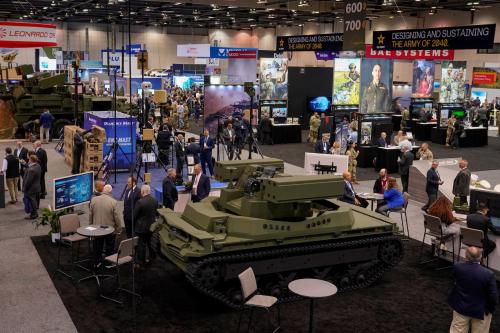The COVID-19 pandemic brought the consequences of offshoring semiconductors into sharp relief for American consumers and businesses. When the pandemic struck—snarling global supply chains and spiking demand for consumer electronics—American businesses and consumers were left without the inputs and supplies they had come to rely upon. This supply chain will remain at risk: Its core nodes remain in locations with high geopolitical uncertainty—none more important than Taiwan, whose semiconductor industry Beijing jealously eyes.
Such supply chain vulnerabilities alongside the recognition that semiconductors represent a strategic resource have inspired a push in Washington to rebuild American chip manufacturing. In June 2021, the U.S. Senate, in a rare act of bipartisan consensus, passed the U.S. Innovation and Competition Act (USICA), which would spend $52 billion to bolster the American semiconductor industry. In February of this year, the House of Representatives passed similar legislation—the America COMPETES Act—along mostly party lines. House and Senate negotiators now must reconcile these bills. President Joe Biden argued in his State of the Union address that passing some version of this legislation was essential “to compete for the jobs of the future” and to “level the playing field with China.”
But reshoring the semiconductor supply chain is unlikely to resolve the supply-chain shocks caused by the pandemic: construction of the most important nodes, namely fabrication of the chips themselves, would require not only tremendous up-front costs, but possibly a steady stream of government assistance in perpetuity. As lawmakers on Capitol Hill iron out how best to position the United States to maintain access to a key technology, it’s worth considering what a more holistic strategy to address semiconductor availability might look like.
Here, we propose a two-pronged approach. First, the United States should focus on deepening its high-tech collaboration with supply-chain partners such as South Korea, Taiwan, or even Europe. The U.S. should also amend immigration rules to permit more skilled workers to enter the country, augmenting the talent pool during a period of labor shortages and increasing the competitiveness of U.S.-based industry. We recommend this combination of policies rather than the costlier and riskier proposition of reshoring the industry from the ground up. The United States may not return to its 40% semiconductor manufacturing market share from the 1990s, but these policies would nonetheless help boost domestic production from 10-12% of the global market and increase supply-chain resilience while minimizing potential efficiency losses from over-reliance on local manufacturing.
Semiconductors and supply chains
The rampant offshoring of chip manufacturing from the U.S. to places such as South Korea, Taiwan, and China made good economic sense for companies in pre-pandemic times. East Asia has cultivated a comparative advantage in semiconductor production by virtue of access to cheap inputs and labor. Turning back the tide, conversely, appears to be considerably more costly. Full-scale self-sufficiency by region, according to a Boston Consulting Group report, would require “$1 trillion in incremental upfront investment, resulting in a 35% to 65% overall increase in semiconductor prices and ultimately higher costs of electronic devices for end users.”
Perhaps more importantly, restoring American chip manufacturing capabilities requires much more than the erection of domestic factories. The production of semiconductor chips involves an intricate set of steps from design to front-end fabrication to back-end assembly, testing, and packaging. Such steps are carried out by different firms and countries that have developed comparative advantages in divergent pieces of the supply chain, such that no country has complete end-to-end control of chip manufacturing. Indeed, as Brookings nonresident senior fellow Chris Thomas notes, this hyper-specialization and complexity “makes semiconductors a winner-take-all industry” such that “the top one or two players in any given niche […] earn all the economic profits in that niche due to scale, learning efficiencies, and high switching costs to customers.”
U.S. companies are among the most important designers of microchips in the world, but the supply chain that supports their physical manufacturing is located thousands of miles away in East Asia. Seven of the top 10 (by revenue) fabless semiconductor design firms—those that design and market the hardware but outsource the manufacturing of silicon wafers to a foundry—are American companies, according to a Congressional Research Service report. But the fabrication facilities (foundries) that make the chips designed by firms like Nvidia and AMD are controlled by Taiwanese and South Korean companies. Other parts of the chain are also equally difficult to reproduce: The most important equipment suppliers are a Dutch and a Japanese firm—ASML and Tokyo Electronics. Back-end production, which is labor-intensive, is concentrated in Malaysia, Vietnam, and the Philippines. For large-scale reshoring initiatives, there’s simply a lot to reshore.
The specialization of the semiconductor supply chain means that efforts to reshore the industry will require more than just the construction of foundries in the United States. These factories will be unable to meet their production and cost targets without reliable access to inputs. Decades of competition among East Asian technology hubs have honed regional supply chains to cheaply and reliably deliver components and materials for semiconductor manufacturing. In the short term, access to critical supplies is likely to remain strained. Russia and Ukraine both provide key inputs for semiconductor manufacturing, such as nickel, palladium, and neon—and the Russian invasion of Ukraine is likely to throw yet another wrench in the global supply chain for chips. The semiconductor industry has sought to increase production, but according to U.S. government data, significant gaps between supply and demand remain. While congressional initiatives to restructure semiconductor supply chains may be aimed at longer-term resilience, the current state of the industry illustrates the complex logistical challenges facing any reshoring initiatives.
Addressing the broader nature of the supply-chain challenge is among the issues facing congressional negotiators trying to reconcile House and Senate bills aimed at boosting U.S. semiconductor manufacturing. The Senate version—the USICA—takes a relatively narrow view of the industries eligible for support, limiting it to microchip manufacturers. The House version—the America COMPETES Act—applies a wider lens and also provides funding for companies supplying equipment and materials used in manufacturing chips. However, the House bill also cuts about $200 billion for regional technology hubs promised in the Senate bill. Invariably, these bills are based on the assumption that the money will be remunerative and assuredly beneficial in propping up domestic industry.
A new era of industrial policy?
As the Senate and House negotiate to work out a compromise between the two pieces of legislation, there is reason to be skeptical about the wisdom of a policy that would reshore the semiconductor manufacturing base. Semiconductor manufacturing facilities will take several years to build. Intel broke ground on two chip factories in Arizona last September, a $20 billion expansion, but the foundry will not be fully operational until 2024. Even once fabrication plants are constructed, it is unclear whether they will be profitable without government assistance. While semiconductor supply chains remain strained, fewer COVID-19-related disruptions and the industry’s efforts to expand capacity may ease shortages in the medium term. The legislation, then, may be a long-term solution to a short-term problem.
The new facilities may bolster the manufacturing base, but companies are facing both blue- and white-collar labor shortages that are likely to be difficult to resolve because of unfavorable demographic, educational, and economic trends in the economy. The Intel plant’s promise of 7,000 construction jobs and another 3,000 permanent jobs therefore faces potential labor challenges. They may be resolved with higher wages, but this raises a different issue: Estimates suggest that the silicon wafers that TSMC is making in Arizona will be more expensive than those made in Taiwan, costs that will be passed along to consumers at a time when consumers are already paying more as a result of high inflation.
Government intervention to prop up the U.S. semiconductor industry and improve its competitiveness would be reminiscent of 20th century efforts to create “national champions” by offering subsidies to firms in domestically popular industries. Politicians have long campaigned successfully on reviving strategic industries, like steel and coal, in which the United States is comparatively disadvantaged, despite the fact that there is no consensus that industrial policy is efficacious. As Daniel Yergin and Joseph Stanislaw document in their book Commanding Heights, the adoption of industrial policies to support domestic industries tends to require a perpetual stream of government assistance to maintain a comparative advantage. A better way to improve the availability of semiconductors and improve the resiliency of the chip supply chain would be to embrace foreign expertise and talent rather than expensive unilateralism.
A third way: partnerships and talent promotion
Even if the United States can reshore some of its domestic manufacturing capacity, the gains will come at considerable cost. Supply-chain resilience should not rely on costly, long-term policies. The United States should be mindful that reshoring risks increasing costs for consumers and consider that countries such as Taiwan and South Korea have developed expertise and efficiency in semiconductor manufacturing and happen to be close American security partners. Foreign direct investment (FDI) in these countries, for example, might allow for a more assured supply of chips. Promoting the expansion of a cheaper foundry abroad, thus, might be far more economical than constructing an expensive one at home.
Furthermore, the United States should welcome foreign firms building manufacturing capacity in the United States, like TSMC’s $12 billion investment in Arizona and Samsung’s $17 billion investment in Texas. Despite these firms not being American, the investments in the manufacturing base are decidedly American, as are the supply-chain advantages brought by insulation from the geopolitical dynamics in Asia.
The United States has long excelled because of its human capital. Yet just as new plants are being built that will require high-tech labor, the United States faces engineering and manufacturing talent shortages. The semiconductor industry can promote STEM skills in universities, but the impacts of those investments will be felt in the medium- to long-term. The government can promote immigration policies that raise the ceiling for high-skilled labor to increase the competitiveness of the U.S.-based semiconductor industry.
In other words, the United States can try to have it both ways—hedging against geopolitical risk in Asia by welcoming investments in American manufacturing and promoting inward migration while also bolstering relations with allies and leading chip producers like South Korea and Taiwan. Doing so mitigates potential security risks without large sacrifices in economic efficiency. Indeed, the logic of comparative advantage that led semiconductor manufacturing to be offshored in the first place still applies today. Promoting “national champions” in an effort to reshore the entire supply chain would only drive up consumer costs at a time when inflation has become a political, economic, and ultimately a national-security liability.
Sarah Kreps is the John L. Wetherill Professor and the director of the Tech Policy Lab at Cornell University and a non-resident senior fellow at the Brookings Institution.
Richard Clark is a postdoctoral fellow at the Niehaus Center for Globalization and Governance at Princeton University and an incoming assistant professor of government at Cornell University.
Adi Rao is a PhD candidate in Government and a fellow in the Tech Policy Lab at Cornell University.
Intel provides financial support to the Brookings Institution, a nonprofit organization devoted to rigorous, independent, in-depth public policy research.



Commentary
A holistic approach to strengthening the semiconductor supply chain
April 7, 2022